Magnum S-9 175 10 Meter Export AM / FM / SSB Review
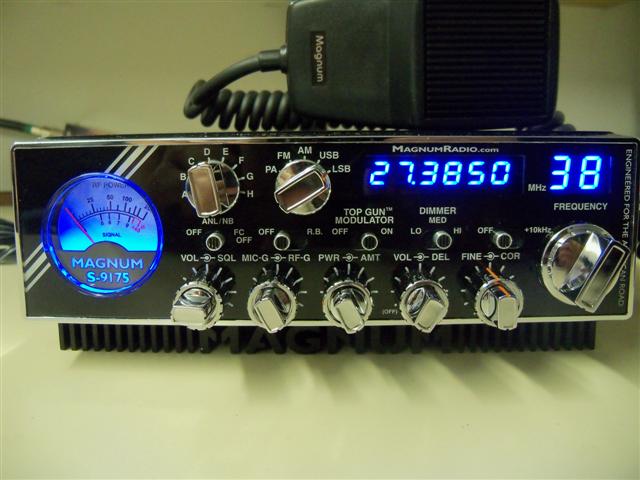
The Magnum S-9 175 is the latest big radio to visit our shack. Since the Magnum S-9 has always been a favorite of mine I was interested to see how I would like it paired with the attached SX-175 amplifier system. This radio is essentially a Magnum S-9 but the bottom cover (and speaker) have been replaced with the SX-175 amplifier system and heat sink. The radio I reviewed also had a newer style of amplifier circuit in the SX-175 which used 2 x 7530ERF transistors.
When unpacking the box the first thing you’ll notice about this radio is that it’s heavy. The heat sink on the SX-175 is one of the most substantial pieces of metal you’ll see on any radio and it has some heft to it. The radio comes with a heavy duty mounting bracket and I’d suggest making sure that where ever you decide to mount it that you use some good strong screws/bolts to secure the bracket. While the radio may be heavy, its size is still very reasonable and the actual radio measurements are almost identical to a regular S-9 with the exception of the height which is increased by the heat sink.
The radio comes with a stock 4-pin microphone which we found adequate and clear but we ditched it in favor of a SRA-158 which yielded better on-air reports. I personally don’t suggest using power microphones with the S-9 in any version. I find the loud clear audio of the Magnum series is very good stock and even better with a very slight adjustment to the AMC. Adding power microphones to these radios just isn’t necessary and I’ve heard many people pushing the modulation too hard with power microphones causing distortion, which is a pity. Is it possible to run a power microphone? Yes, but you’ll want to back off the microphone gain and be aware of your modulation levels.
The radio comes with good sized power wire with a quick disconnect and for best results I’d suggest making sure you have 25 amps available for the power supply. For testing in a base install I chose to use my 36 amp power supply and it was more than adequate to run this radio.
One of the features that Magnum has included on their S-3, S-6 and S-9 version is the large round meter which is easy to read and is illuminated with the matching blue lights. Now while the scale itself is still fairly small, the overall size of the meter makes it easy to get a general idea of signal strength, etc. The meter is blue on receive, red on transmit and if you have high SWR it will flash red intermittently.
10 meter or “export” radios such as this model come with a band selector which switches between different frequency ranges. The mode selector just to the right is for picking a mode of operation – LSB (lower side band), USB (upper side band), AM (amplitude modulation), FM (frequency modulation), PA (public address).
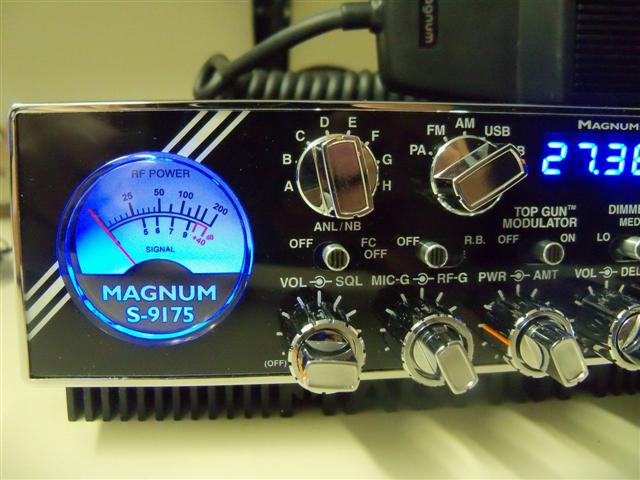
To the right of the mode selector is your 6 digit frequency counter. This is an active frequency counter unlike many other radios that only have a 6 digit frequency display which doesn’t show the actual frequency. Few SSB export radios offer the 6 digit counter and it’s a nice feature. To the right of that is your standard channel display.
On the second level are the switches (2 and 3 function switches). First is the ANL/NB switch which has an off, on, and a third position which turns off the frequency counter. Next is a Roger Beep on/off switch and following that is the Top Gun Modulation switch. The Top Gun Modulator functions only in AM mode however this radio also has the Top Gun Compressor which functions in both AM/FM/SSB modes. To the right is the dimmer for the display with Lo/Med/Hi options. Last is the +10kHz switch which allows the radio to jump up 10kHz.
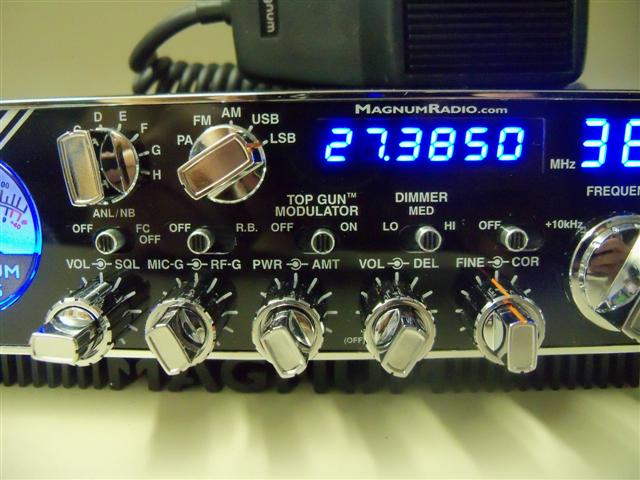
On the bottom row are your control knobs, all of which are dual function with inner and outer controls – Volume, Squelch, Microphone Gain, RF Gain, Variable Power, All Mode Talkback, Echo Volume, Echo Delay, Fine Clarifier, Coarse Clarifier. Last is the largest knob which is the channel/frequency changing knob.
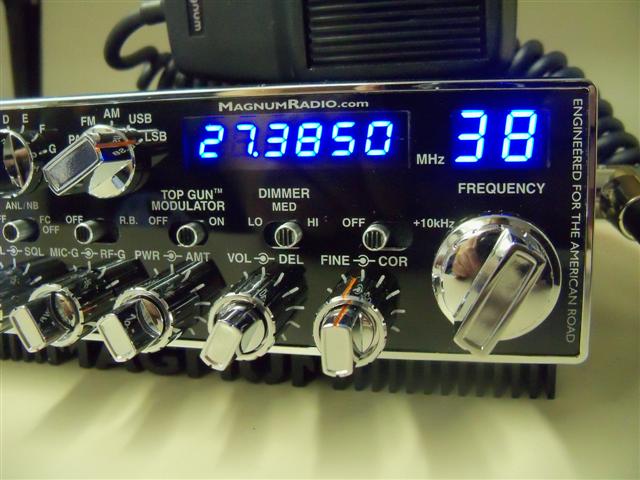
At the back of the radio you’ll find a heat sink to help dissipate heat from the 2 x ERF2030 transistors in the main radio. There is a small on/off switch which is for radios with Nitro knobs and also turns the SWR warning indicator on/off. The antenna SO-239 connector is on the back along with the PA speaker jack and the Ext speaker jack. The power cord is a bit different than most standard radios as you don’t plug the connector into the radio, instead the wires come out of the radio and there is a quick disconnect for plugging/unplugging the radio to the power source. The power cord is 12 gauge wire which is larger than the standard power wires sold for most CB radios.

From the top view you can see the size of the radio and get an idea of the size of the heat sink on the back of the radio.
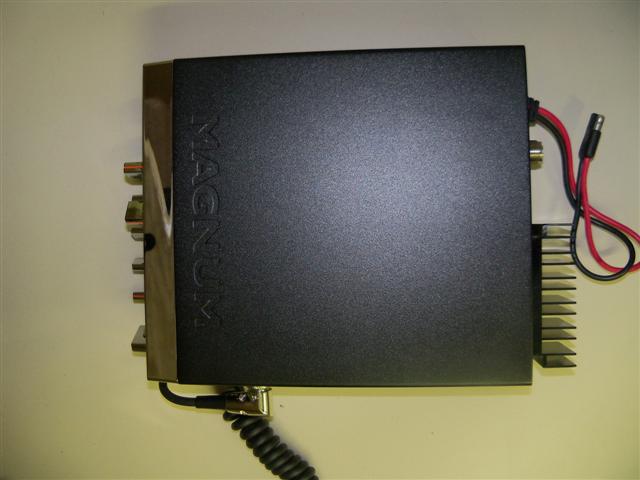
A neat feature on the Magnum S9 radios is that they have dual microphone jacks, one on each side of the radio. Both jacks are 4 pin (standard Cobra, Galaxy 4 pin wiring) and you can plug into either side or even both sides with two different microphones. This gives you more options for mounting.
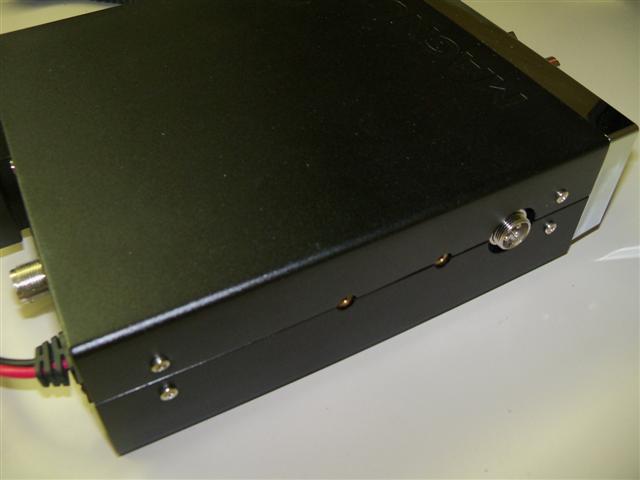

Looking at the bottom of the radio you’ll see the large heat sink and its ridges. Since this radio has an amplifier section built into the bottom, getting rid of heat is very important and this large heat sink does an excellent job. It also is pretty trick looking as Magnum was able to have their name machined as part of the heat sink to display at the front of the radio.
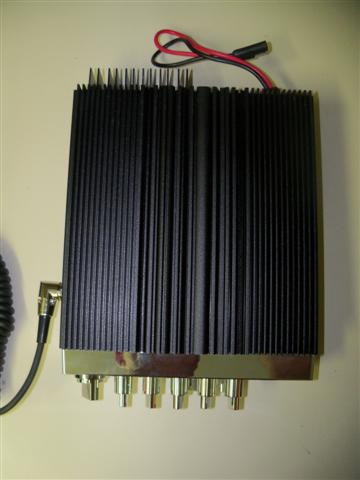
Looking inside the radio you’ll find it looks very similar to the standard Magnum S9 and the echo, talkback, and frequency counter boards are visible. At the back of the radio is where the radio will look different with the wiring running out from the main board and connecting to the amplifier section.
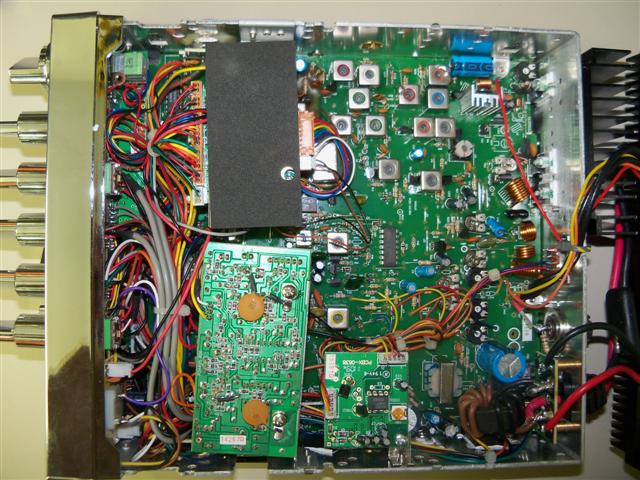
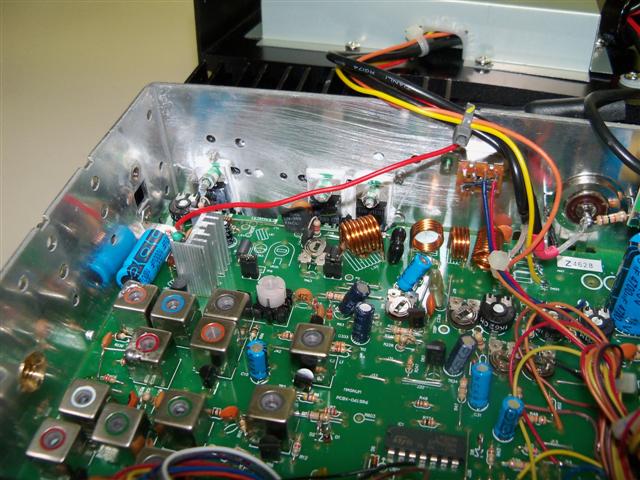
The amplifier section is housed on the bottom cover/heat sink and has a cover over it. For most people there should never be any reason to remove this cover. Since the location of the amplifier section is in the middle of the bottom cover you’ll notice the lack of an internal speaker. Some of the other manufacturers solved this problem by using a smaller speaker in the cover but Magnum decided to include an external speaker with this model so you don’t have to compromise sound quality.

Once you remove the amplifier cover you’ll see the small amplifier circuit board with two ERF-7530 transistors mounted. The benefit of this system over the multi-transistor setups is that the circuit is simpler and the transistors are larger and more rugged than the smaller ERF-2030’s. With 2290 and 2879 transistors getting more expensive and harder to find, manufacturers are having to choose different methods to build amplifier sections for their radios. I have to say I prefer the 2 transistor setup compared to the 4 transistor or even 8 transistor setups we’ve seen on some radios.
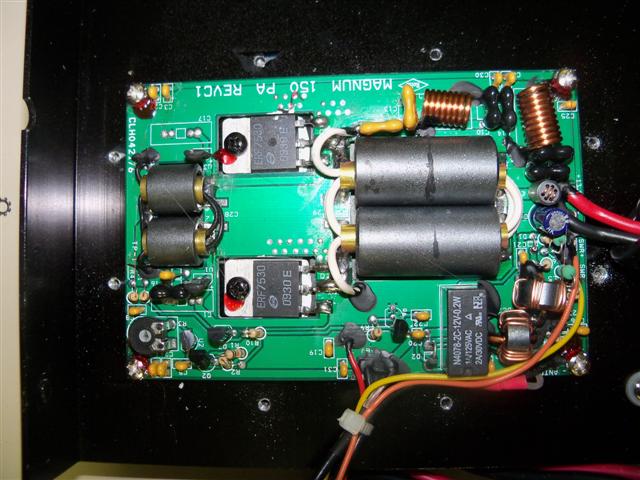
FEATURES WORTH MENTIONING
- Variable Talkback – The all mode talkback in the Magnum S-3, S-6, and S-9 series is about as close to perfect as you’ll see on an export radio. Many CBer’s like to adjust their audio or echo and having the all mode talkback makes it simple and easy. It’s completely variable and you can shut it off when not needed.
- Variable Power – A radio that can do 100+ watts is great, but a lot of the time you won’t need to run the radio at full power so it’s nice to be able to turn down the output and set the dead key where ever you want. For those of you who intend to use this radio as a driver for your amp the variable power is a necessity. Note: Variable power works on AM but doesn’t effect SSB peak output.
- Magnum Echo – The Turbo echo on Magnum radios is one of the best in the business and if you’re someone who likes echo on your radio you can’t go wrong with the effects and adjustability you’ll find on this model.
- Top Gun Modulator & Compressor – The Magnum S9 series have both the Modulator circuit and the Compressor. Together they give the Magnum S9 some of the best punchy audio you’ll find on an export radio.
TESTING & OUTPUT
DX had been quiet for a while when I first got this radio and so I had the opportunity to try to make some contacts during less than ideal conditions. I also decided to run this radio in its stock form to gauge what kind of tuning I might want to do after the initial testing.
In stock form the radio was dead keying around 25 watts AM and swinging to around 130 watts on AM. On SSB the radio was peaking around 130 watts. With average SSB peak around 110-120 watts.
I was running the radio with a Wilson 5000 magnet mount as I wanted to see how it would do in a very simple no-hassle setup. The majority of my testing was on SSB and the 100+ watts made contacting DX stations easy. When we discuss ideal wattage for making DX contacts 100 watts is really the starting point (most Ham HF radios are 100 watt versions these days). On AM the wattage did allow me to make some contacts on channel 17 and 19 and I did get my handle called on the superbowl (ch 6) one afternoon, but it was decidedly more difficult than SSB. With all the big stations running 500+ watts on AM these days shooting skip on the AM side in less than perfect conditions requires a little more juice to get heard in many cases.
Locally I got great feedback on the audio and had no trouble contacting any of the locals. The stock audio quality on the Magnum radios is very clear, clean and punchy.
After about a month I was greeted with the noticeable up-tick in DX that we’ve been enjoying for the last month or so now. This is where I really put the Magnum S9-175 to work. I’ve been talking daily on the radio for the last month making contacts from Ireland to Australia and everywhere in-between (all from the mobile). While I had been running a barefoot CB in my other vehicle and had been able to make contacts after a lot of calling I found switching cars and running the 130+ watts of the S9-175 made all the difference. On air reports again were excellent and the heat sink of the radio only got mildly warm even during heavy use. Once again this is the un-tuned, unmodified, stock radio.
The SSB stability of the S9 series is good, rating higher than many of the other exports on the market but still coming in below the Magnum Omegaforce, 257, and 2950DX series. While the radio doesn’t experience any huge drift issues during operation I found that in a vehicle install where the temp drops overnight that when I turned on the radio in the morning it would be 1-2 cycles off from where it was when warm the day before. I would get in the vehicle in the morning to find the frequency counter reading 27.3851 and would make the minor adjustment back to 27.3850.
One other thing worth mentioning about this model is that the variable power has no effect on SSB output. I could turn it to low and the SSB output will still be peaking at its maximum.
Lastly – while this radio is marketed as a 10 and 12 meter radio I assume most people are performing modifications and are using this as an export radio. I did actually venture into the 10 meter band (as a licensed ham radio operator) and made DX contacts with this radio, but because of the tuning steps on the radio being channelized it isn’t the easiest place to operate. Possible, yes, but if you are looking for a dual use export radio I might suggest you look at the Magnum 257, Yeticom Optima, or RCI-2950DX.. While many ham radio operators have a negative view of export type radios I did have two different contacts on 10 meters specifically tell me that this radio sounded fantastic on the air.
CONVERSION FOR 11 METERS (CB)
From the factory these radios are set up to work on 10 meter ham radio frequencies. To use the radio on CB channels requires moving a jumper inside the radio for the conversion. You’ll have to remove the bottom cover (be careful as the bottom cover has the amplifier section and wires running to the back of the radio). For full instructions click here.
AFTER INTERNAL ADJUSTMENTS
I did perform a very mild tune on the radio adjusting the SSB peak output pot from a 9:30am position to a 10:30am position. This yielded an increase in wattage of roughly 10-20 watts with peaks around the 140-160 watt range. I also adjusted the AMC up slightly which increased the audio but only saw a small increase in wattage as the Top Gun already allows for a lot of swing. Once again these were very mild adjustments and did not result in increased distortion or excessive heat during long DX QSO’s.
From the factory the frequency counter was reading a hair high so I did adjust the counter as well while the radio was open and it has remained true for my testing since.
SUMMARY
The Magnum S-9 175 is a highly capable export radio and its Magnum exclusive features such as AMT, Turbo Echo, and Top Gun components really make it a desirable all around export radio. The added wattage over the standard S9 means you don’t need an external amp to feel like you can make some contacts on the air. When combined with a quality antenna you really have a deadly combo.
For you AMer’s this radio offers great audio (stock or with some adjustments to the AMC you can make it even louder). For the SSBer’s they’ll appreciate its punchy audio and warm natural receive. For the hard core SSBer is it the most stable export on the market? No, a few models have it beat but relative to the rest of the market it definitely is in the top tier.
I will recap a couple of points – although radio has good frequency stability I still found some small adjustment to the coarse clarifier necessary at times. Secondly, the lack of a SWR meter on the display may be a talking point for some people but truthfully if you’re going to run this type of model putting out 100+ watts you really should own/use an external meter. Lastly, I would have liked to see the variable power control the peak output on SSB as there are cases where I might want to drop the SSB output down to the more typical 35 watts.
Overall the Magnum S-9 is still at the top of the game for the export market. I can recall my excitement years ago when I saw the first photo of the S-9 and each time I’ve had the chance to operate one of these radios it’s been a blast. They really are fun radios and there are enough features to keep just about every CBer out there happy. The SX-175 with the larger 2 transistor setup seems like good replacement in lieu of the more traditional 2290’s that were discontinued and the 100+ watt output is the perfect level for talking DX.
To finish off this review I’ll give a quote from a DX contact I made yesterday. I told WT500 (TX) I was testing out the Magnum S9-175 for a review and he said, “If I had to rate the sound of that radio on a 1-5 scale I’d give it a 4.5. It’s one great sounding radio”.
| OVERVIEW VIDEO |
